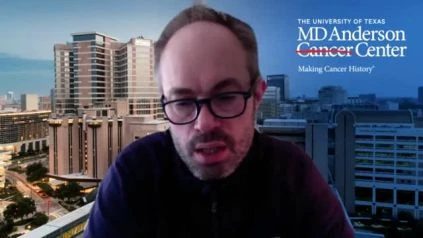William G. Wierda, MD, Ph.D. – Professor Department of Leukemia, University of Texas MD Anderson Cancer Center speaks about ASH 2020 abstract – The first presentation of disease-free survival results from the CAPTIVATE study evaluating Imbruvica plus venetoclax as a time-limited treatment in first-line CLL (Abstract #123).
Context:
In a randomized phase 3 trials in first-line CLL studies, Ibr is a proven standard of care in CLL and is the only once-daily Bruton tyrosine kinase inhibitor with a substantial overall survival benefit (RESONATE-2; ECOG1912). The synergistic combination of Ibr + Ven (oral BCL2 inhibitor) has been shown to mobilize and clear CLL cells from multiple deep-response disease compartments, offering a basis for evaluating time-limited therapy (Jain et al. NEJM 2019). CAPTIVATE (PCYC-1142) is a first-line Ibr + Ven multicenter phase 2 (NCT02910583) study with 2 cohorts: Minimal Residual Disease (MRD) and Fixed-Duration (FD). Patients (pts) received 3 cycles of Ibr lead-in for both cohorts, followed by 12 cycles of combined Ibr + Ven. Pts in the MRD cohort were randomized to placebo or further therapy by MRD status. Ibr + Ven resulted in high rates of undetectable MRD (uMRD) in both peripheral blood (PB; 75 percent) and bone marrow (BM; 72 percent) in the pre-randomization process of the MRD cohort, with reliable uMRD results in 93 percent of pts with matched samples (Tam, ASH 2019). Primary findings from the MRD-guided randomization process of the MRD cohort are discussed, examining if this regimen enables treatment-free remission in the uMRD environment.
Methodology:
Three cycles of Ibr lead-in accompanied by 12 cycles of Ibr + Ven (Ibr 420 mg/day PO; Ven ramp-up to 400 mg/day PO) earned Pts <70 years with previously untreated CLL/SLL needing therapy. After 12 cycles of Ibr + Ven, pts with Confirmed uMRD (defined as uMRD serially over ~3 cycles and in both PB and BM) were randomized 1:1 to receive double-blind placebo or Ibr treatment after 12 cycles of Ibr + Ven; pts that did not meet the concept of Confirmed uMRD were randomized 1:1 to receive open-label Ibr or continued Ibr + Ven treatment. In the confirmed uMRD pts randomized to placebo vs Ibr, the primary endpoint was a 1-year DFS rate; DFS was described as progression-free survival or MRD relapse. Rates of uMRD (<10-4 by 8-color flow cytometry), iwCLL response, progression-free survival (PFS), and adverse effects were key secondary endpoints (AEs).
Outcomes:
The MRD cohort had 164 pts enrolled. The median age was 58 years (range, 28-69); baseline high-risk characteristics included 16 percent del(17p) and 17 percent del(11q); 20 percent del(17p) or TP53 mutation; 19 percent complex karyotype; and 60 percent unmutated IGHV . The median study time was 31.3 mo (range, 15.0-41.0). With 3 cycles of Ibr lead-in accompanied by 12 cycles of combined Ibr + Ven, 90% of pts completed the targeted treatment. Of 149 randomized patients, 86 (58 percent) were randomized to placebo (n=43) or Ibr (n=43) with Verified uMRD (100 percent uMRD in PB and BM). 63 of 149 pts (42 percent) did not achieve Confirmed uMRD as described above and were randomized to Ibr (n=31) or Ibr + Ven (n=32); 48 percent in PB and 32 percent in BM were uMRD rates at randomization in this group. The 1-year DFS rate for pts randomized to placebo was not substantially different in the Reported uMRD community (95.3 percent; 95 percent CI 82.7-98.8) versus Ibr (100 percent; 95 percent CI 100-100) (P=0.1475; figure). During the overall study period, uMRD rates increased to 57 percent in PB and 54 percent in BM in the group without Verified uMRD who were randomized to continue Ibr or Ibr + Ven. Across all randomized weapons, 30-mo PFS rates were >95 percent (Table). Complete endpoint results for randomized weapons will be provided. The median period of care with Ibr was 28.6 mo (range, 0.5-39.8) and with Ven was 12.0 mo (range, 0.8-34.1). AEs were predominantly graded 1/2 and often occurred in early Ibr + Ven periods, with minor randomized treatment arm variations. Neutropenia (36 percent), hypertension (10 percent), thrombocytopenia (5 percent), and diarrhea were the most common grade 3/4 AEs (approximately 5 percent of pts) during the overall study period among all-treated pts (median treatment length 29 mo) (5 percent ).
Findings:Â
Treatment with first-line Ibr + Ven is an all-oral, once-daily, chemotherapy-free regimen that offers elevated levels of PB and BM uMRD in CLL pts and a 90% reduction in high-risk TLS monitoring (Siddiqi, EHA 2020). After the combination of Ibr + Ven, the 1-year DFS in pts randomized to placebo was close to that of pts continuing Ibr, endorsing a fixed-duration therapy that provides treatment-free remissions in pts with CLL/SLL. The depth of response obtained with this regimen is expressed across all treated pts in the 30-mo PFS rate of ~95 percent. Ibr + Ven’s safety profile was compatible with established AEs for Ibr and Ven, and there were no new safety signals.

